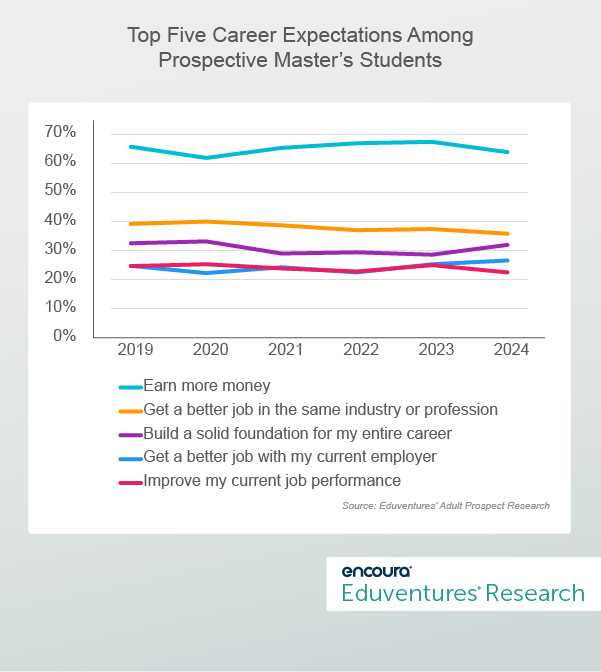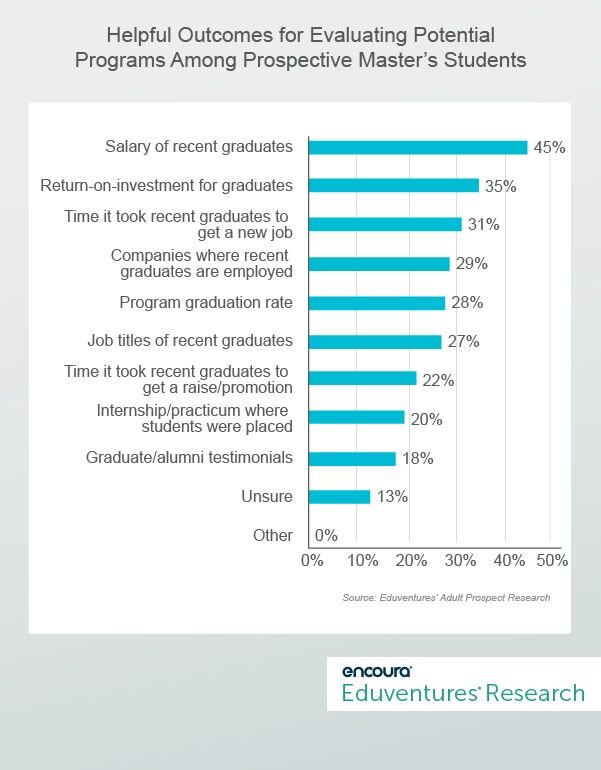When considering a return to higher education, prospective master’s students are decidedly driven by career expectations. For example, in 2024, just 6% of master’s degree prospects told us that their desires for continuing education were not related to their careers. So, it stands that master’s degree programs must be able to tell a compelling career outcomes story to stand out in an increasingly competitive market.
But what exactly are these prospects looking for and what do they find helpful when evaluating a program’s outcomes? New data from Eduventures’ Adult Prospect Research™ sheds some light on this question.
Career Expectations – Show Me the Money
Each year, we ask prospective master’s students about their top three career expectations for continuing their educations. Figure 1 tracks the top five responses from 2019 to 2024.
Figure 1.
Two-thirds of prospective master’s degree students report that “earning more money” is among the top three. And the gap between that response and the second most-cited response, “get a better job in the same industry or profession,” isn’t particularly close, (20+ percentage points).
Notably, the top five responses in Figure 1 also center on alignment to one’s job: whether it’s finding a better job, improving performance in a current job, or building a solid foundation for long-term job trajectory. Responses that fall outside of the top five include switching careers, staying ahead of automation, and others.
Without a doubt, making more money is top-of-mind for prospects followed by a range of job improvement motivations. How do these career outcome expectations influence what type of information might sway them to choose your master’s programs?
Career Outcomes – Show me Your Data
Many of us are familiar with the way that outcomes are generally positioned within master’s programs. Most marketing efforts include some language around the types of jobs graduates may get upon program completion backed up with generalized data on job-specific projected growth and earnings. It’s just enough information to sketch a possible outcome: “through this program, you can become a healthcare administrator, a job that is projected to grow by 26% in the next decade, whose median earner makes $110,000 in annual wages.”
This can provide a useful window into an academic program. But when it comes to evaluating program options, prospective master’s students really want to see exactly how successful your program is at helping graduates reach these goals.
Figure 2 reveals responses to a new question included in Eduventures’ Adult Prospect Research this past fall about what kind of information is most helpful in the evaluation process.
Figure 2.
Almost half of master’s prospects want to see actual salaries of recent program graduates. This response beats all others by at least 10 percentage points. About 35% of master’s prospects want to understand the return-on-investment (ROI) perspective that considers both cost and post-program earnings. Almost one-third want to understand how long it took for recent graduates to get a new job.
In the next cluster of responses, we see examples of companies where graduates work (29%), the program’s graduation rate (28%), and recent graduates’ job titles (27%) all neck-and-neck. This response data clearly shows that prospects want to know what actual graduates have achieved upon program completion, not just what is possible.
This begs the question, is anyone doing this well?
It’s not uncommon to see one or two of the outcomes information types from Figure 2 included in a program’s positioning, but here are a handful of programs that check at least three boxes:
- The University of Michigan’s Ross School of Business offers a variety of useful data points for its MBA and one-year master’s programs. For example, prospective students interested in the Master’s in Supply Chain Management can find that the average salary of recent graduates is $106,000 and that graduates, on average, reported a signing bonus of $20,000. This data is also filtered through industry, function, and region segmentations. For example, 76% of graduates accepted a job in operations/logistics with an average salary of $103,000 versus 11% of graduates working in consulting with an average salary of $109,000. Further, prospects can see that 90% of graduates received a job offer within six months of graduation, and that Rivian, Deloitte, Amazon, and L’Oreal are among the program’s top hiring companies. Finally, several student testimonials are available.
- American University’s individual program webpages provide some detailed information like the fact that 93% of its Master’s in Analytics program graduates were employed within six months of completion and that Cisco, Gartner, and Booz Allen Hamilton are among employers of recent graduates. American’s We Know Success platform, however, allows for deeper exploration of outcomes data at the program level by segmenting outcomes data by degree level and field. For example, we can find that 75% of Master’s in Analytics graduates are working in the for-profit sector for employers like Goldman Sachs, Hilton, and Guidehouse. We can also discover that 50% of graduates make over $70,000 but that 7% are making less than $50,000. During the program, students participated in internships at Freddie Mac, the U.S. Secret Service, and more.
- The University of Illinois Urbana-Champaign’s (UIUC) iMBA program is well known for breaking the online MBA degree mold, but it also takes strides in attempting to speak to the ROI factor – perhaps the unicorn of all outcomes-type metrics in that many prospects want to see it, but it is rarely there. UIUC reports ROI in a few ways, like through applicability (e.g., 95% of graduates applied what they learned to their work), advancement (e.g., 65% of graduates received a promotion, job offer, or new position during the MBA), and pay (e.g., a 25% average pay increase during the program was reported by graduates). Other measures provided include overall program satisfaction, program recommendation rates, program retention rates, and employers of graduates.
The Bottom Line
In an increasingly competitive market, a program’s ability to demonstrate strong outcomes is now critical. Our conclusion—based on reviewing thousands of program websites a year—is that differentiation is becoming much harder. While more institutions are innovating on price, promising flexibility, and signaling career relevance, detailed and program-specific outcomes still remain unchartered territory for many.
Of course, this data can be hard to capture. Program alumni can become hard to track down—and harder still to get a response from (notice some of the best examples of this type of reporting come from large, brand-name schools). But this is hard work worth doing. In this market, matching program outcomes to prospect expectations may just make or break program enrollment goals.
Our advice is to embrace an approach that starts with stories but ends with statistics. A good story engages emotions and piques interest, while statistics offer essential information for rational decision making. Together, that’s a powerful combination. Later this year, Eduventures will be exploring master’s level earnings data from the College Scorecard to clarify this space even more.

Eduventures Summit – higher education's premier thought leadership event – is returning to the Windy City next year. Secure your spot today!



